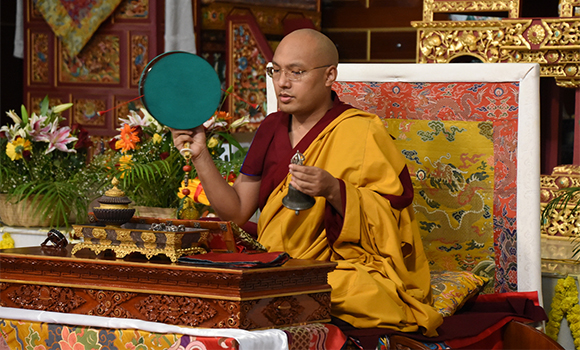法王新闻 | 2016年02月
『第3届讖摩比丘尼』主持施身法法會
『3rd Arya Kshema』Presides over a Day of Chö Puja

時間:2016年2月2日 February 2, 2016
地點:印度 菩提迦耶 德噶寺 Tergar Monastery, Bodh Gaya, Bihar, India
Following the final day of teachings at the Arya Kshema Winter Dharma Gathering, the Gyalwang Karmapa presided over a full-day Chö puja with all the participating nuns. The text that was chanted is called Chö: A String of Jewels and was composed by the 3rd Karmapa Rangjung Dorje.
在讖摩比丘尼冬季辯經法會的《解脫莊嚴寶論》課程圓滿後的翌日,法王噶瑪巴親自帶領全體尼師共修一整天的施身法。法會儀軌為第三世噶瑪巴讓炯多傑所著的〈施身法——寶鬘〉(Chö: A String of Jewels)。
Since the time of the 3rd Karmapa, Rangjung Dorje, who wrote the first commentary on Chö and who also compiled the text of this puja, the Karmapas have had a strong connection with the Chö practice. Historically they are holders of the direct Chö lineage, based on the Indian Buddhist deity Prajñāpāramitā, who is known as both the mother of all the Buddhas and the embodiment of wisdom.
施身法起源於諸佛之母和智慧的化身——印度佛教本尊般若佛母(Prajnaparamita)。第三世噶瑪巴撰寫了施身法的第一部論釋,自此,噶瑪巴便與施身法的修持有了深厚的因緣,歷代噶瑪巴都是施身法直接傳承的持有者。
Chö, which means “to sever or cut” in Tibetan, ultimately aims to cut through the ignorance of self-grasping that is the root of all our suffering, using the wisdom that realizes emptiness. It is renowned among the eight practice lineages of Buddhism as being the only lineage established by a woman, the great female master Machik Labdrön and the only one to pass from Tibet to India. Female practitioners have been known to traditionally excel in Chö practice.
施身法的藏文發音為「確」,是“斷除”之意,其究竟目的是以證悟空性的智慧來斷除無明我執,而無明我執被認為是我們所有痛苦的根源。施身法是藏傳佛教八大實修傳承中聲名斐然的一支,由偉大的女性上師瑪姬.拉尊(Machik Labdron)所創,它不僅是唯一的由女性開創的傳承,也是唯一的從西藏傳到印度的傳承。傳統上認為女性修行者在施身法的修習上更勝一籌。
Starting at daybreak long lines had formed outside the shrine entrance of people eager to participate in the puja. Many monks and lay people lined the outer and back rows of the shrine, as well as filled the space on the veranda surrounding the shrine. There were also many people in attendance clothed in the white and red ngagpa robes of lay tantric practitioners. In total it is estimated around 1000 people were in attendance.
天剛微亮,大殿入口前就排起了長長的隊伍,人們踴躍地前來參加這場法會,就連環繞大殿的走廊上也坐滿了許多的僧眾和居士,人群當中還有很多人穿著紅白相間的密乘瑜伽士的服裝。據估計這次法會的參加者約1000人。
The day was full of color and the beautiful melodies of the Chö. The Karmapa sat on the central throne, wearing his yellow outer monastic robe (chögu) and presiding for the entire day as Dorje Lopön, or vajra master. Hundreds of nuns sat in rows of raised platforms and carpets facing each other, also wearing their yellow outer robes. Nearly all the nuns also played the special Chö drums and bell used in the practice, filling the space with the green circles of the turning drums as well as the rhythmic sound. At points in the puja the haunting sound of kangling horns reverberated through the air, evoking the severing of gross attachment to the physical body that informs this practice.
當天,法會現場充滿花鬘的繽紛色彩和施身法的優美旋律。法王噶瑪巴坐在中央的法座,穿著黃色僧袍,擔任法會的金剛上師。數百位尼師整齊地排坐在架高的座位上,同樣穿著黃色的僧袍。幾乎所有的尼眾都操持著施身法中特有的鈴和鼓,伴隨著綠色的圓形手鼓的旋轉,優美的旋律迴盪在會場上空。法會過程中,不時迴旋著脛骨號的徹骨法音,提醒著會眾切斷對軀体的粗重執著。
As with all the practices performed during the Arya Kshema Winter Dharma Gathering, the nuns took the key roles in the puja, such as the chant masters, and the musicians playing the large puja drums and other instruments. During the afternoon’s feast offering, a group of nuns, facing the Gyalwang Karmapa and each holding up a feast offering, offered him a song.
讖摩比丘尼辯經法會中所有修法的重要工作都由尼眾擔任,例如維那師、大法鼓的鼓手等。下午的盛大供養中,由一群手持供品的尼師,在法王的面前獻上法音。
The ritual concluded around 5pm and created a perfect preparation for the arrival of Jamgon Kongtrul Rinpoche who came soon after. Several lines of nuns, monks, and laypeople lined both sides of the road and the pathway into the shrine. When he came, three nuns skillfully played the gyalings horns to lead the entrance party past many people holding katas to joyfully greet this precious master.
法會在下午5點左右圓滿,正好有充分的時間準備迎接即將蒞臨的蔣貢康楚仁波切。道路的兩旁和通往大殿的通道上,站滿了手持哈達的僧眾、尼眾和居士。當仁波切抵達時,三位尼師嫻熟地吹奏起法號,在大眾虔敬地注目下,引領仁波切一行進入德噶寺。
网页修改记录:2024年3月12日,新建网页,放YOUTUBE视频链接、剪辑音频、标题图片和中英文本。
Youtube 视频
